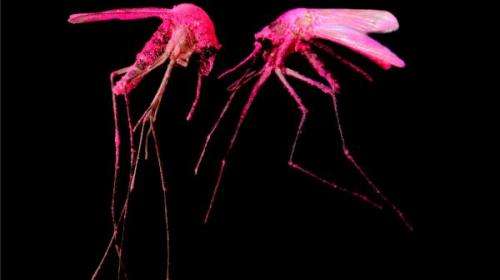Fluorescent pink mosquitos help researchers identify breeding grounds

Two thousand fluorescent pink mosquitos are helping scientists identify mozzie breeding grounds and assess the effectiveness of a larvicide used for 15 years in the Shire of Kalamunda.
A sustained release control agent, Prolink mimics a mosquito hormone that prevents larvae from developing into adults, but its effectiveness has not been fully assessed until now.
To measure its impact, Associate Professor Jacques Oosthuizen from Edith Cowan University's School of Exercise and Health Sciences says his team captured about 2000 mosquitos from stormwater gullies in Kalamunda.
"We coat the gully mosquitos in pink, release and recapture them," he says.
"It does make them look a little bit odd, but by counting the number of pink mosquitos we catch later on in traps, we can determine how far they spread out from point sources of breeding."
A/Prof Oosthuizen says the black-to-pink ratio of recaptured mosquito samples becomes clear under a microscope, allowing researchers to gauge how many are actually becoming a nuisance in the neighbourhood.
To further assess Prolink's effectiveness, the briquettes are either floated on water in the gullies or embedded in gully sediment, allowing researchers to monitor and compare the efficacy of each method.
The team then scoop larvae from gullies, allow them to mature in the lab, and assess the percentage of adult mosquitos that successfully emerge.
Early indications suggest the hormone treatment isn't working as well as it should.
Breeding grounds
A/Prof Oosthuizen says the pink mosquitoes have also helped his team identify where mosquitoes breed in Kalamunda.
"We basically want to see if mosquitos around the houses in Kalamunda are actually breeding in the drains, or in the gullies."
Although the data is yet to be analysed statistically, researchers believe the key to managing mosquito populations may be modification of stormwater drains, which can be reengineered to stop them from holding onto residual water and becoming breeding grounds.
"It is early days, but the results are already supporting the intervention of reengineering the drains," says A/Prof Oosthuizen.
The project also involves setting up 25 carbon dioxide light traps to sample mosquito populations in Gooseberry Hill and Maida Vale.
The Department of Health has funded the research as part of a strategy to reduce mosquito numbers.
This study links into a State Government initiative to control mosquito populations across the state, and a report is planned for 2015.
Provided by Science Network WA


















